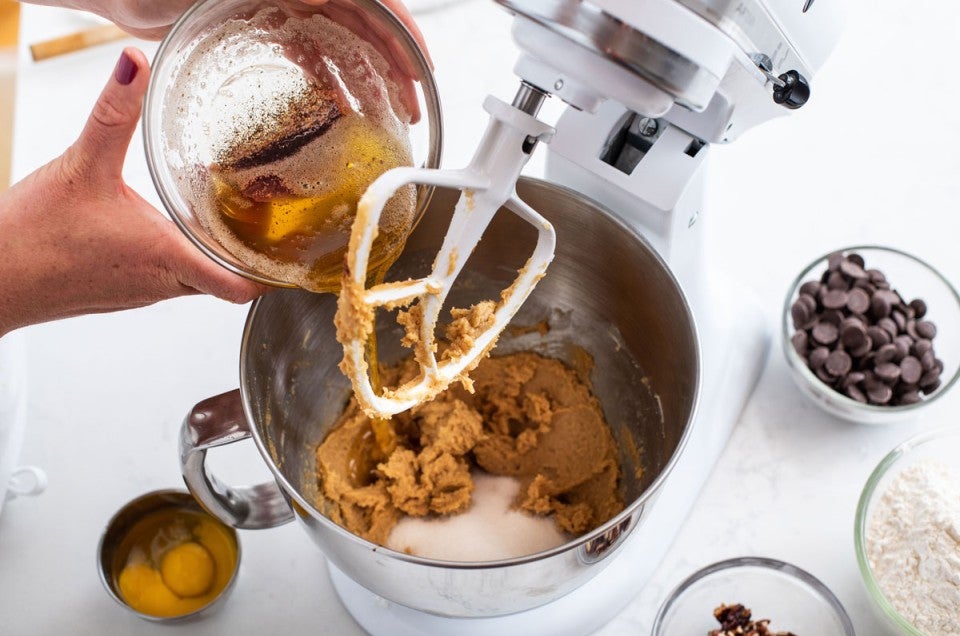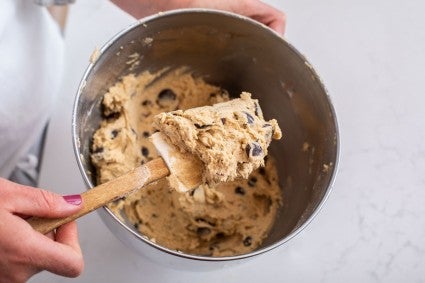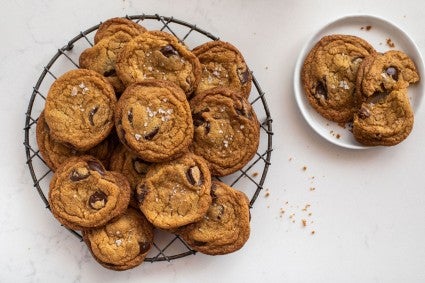A butter trick for better chocolate chip cookies
For flawless chocolate chip cookies, bakers brown their butter — but only some of it.


It’s been 10 years, but Joy Wilson, a.k.a. Joy the Baker, still remembers the moment she first added brown butter to her chocolate chip cookie recipe. The move was, as many of the things she bakes are, inspired by her dad.
“My dad’s a baker, and he’s one of the reasons I’m a baker, and he’s had different iterations of chocolate chip cookies my whole life,” she says. “An iteration he really liked was a weird one: He would add two tablespoons of Orville Redenbacher’s butter, which isn’t actually butter, to his cookie dough.”
That “butter” is actually an oil that gives popcorn the singular and elusive richness of movie theater popcorn — the same flavor it imparted to the cookies. “It was delicious,” Joy says. “But I was like, ‘Dad, what you're trying to get, I think you can get from butter itself.’”
To prove it, Joy created a cookie that features butter in not just one form, but two. In her Brown Butter Chocolate Chip Cookies with Pecans, one stick of butter is softened, ready to be creamed with sugar, while the other is cooked until it’s melted, liquefied, and browned.
The brown butter did what Joy (and her dad) hoped: It brought a bold, toasty, and almost savory butteriness to the cookie’s forefront. A strong hand with the salt highlighted those flavors even more.

A baker can be forgiven for thinking that Joy could have gone the extra mile and browned both sticks of butter in the recipe — but if she had, the result may not have been nearly as good. Recipe developer Holly Haines, who also browns half the butter in her chocolate chip cookies, learned that the hard way.
“I’ve browned all the butter before and ended up with a gritty dough, and that’s no fun,” she says. (Even worse, a cookie made entirely with brown butter can come out greasy and crumbly.) “Browning all the butter removes the water content, but the dough still needs some of that water to come together. Browning only some of the butter is enough to achieve that signature nuttiness, while the remaining unbrowned butter provides enough water content for the dough to come together.”
The fact that only half of the butter is browned in these recipes is also what makes it a technique you can apply to any chocolate chip cookie (or, for that matter, any cookie at all). Because butter is primarily made up of fat, “when you brown half the butter, you’re not taking that much water out,” says Frank Tegethoff, one of the specialists in King Arthur’s research and development kitchen. That relatively small amount of lost water means that the impact on a cookie recipe is likely to be minimal: “Spread’s not going to change, loft isn’t going to change.” The only thing that might change — and here Frank emphasizes the word might — is that the cookies may have slightly crispier edges, something many folks will see as a feature, not a flaw.

Divide the butter the recipe calls for in half. Brown one half, and keep the other exactly as the recipe calls for. If the recipe calls for creaming the butter with sugar, do that with the unbrowned butter, then pour in the (now slightly cooled) brown butter and beat for another minute or two. (If you wish, you can also chill the brown butter to return it to a more solid state and cream it alongside the unbrowned butter, but this isn’t necessary.) Whatever you do, always add the brown butter before adding the eggs and dry ingredients — otherwise you risk changing the texture of your cookie.
Alternatively, you can just make Joy’s recipe, adapting it to suit your tastes. Add mix-ins, take mix-ins out, make the cookies huge, or make them really small. “I make these without the nuts all the time,” Joy says. The nuttiness that comes with brown butter, on the other hand, is non-negotiable.
Cover photo by Jenn Bakos.

